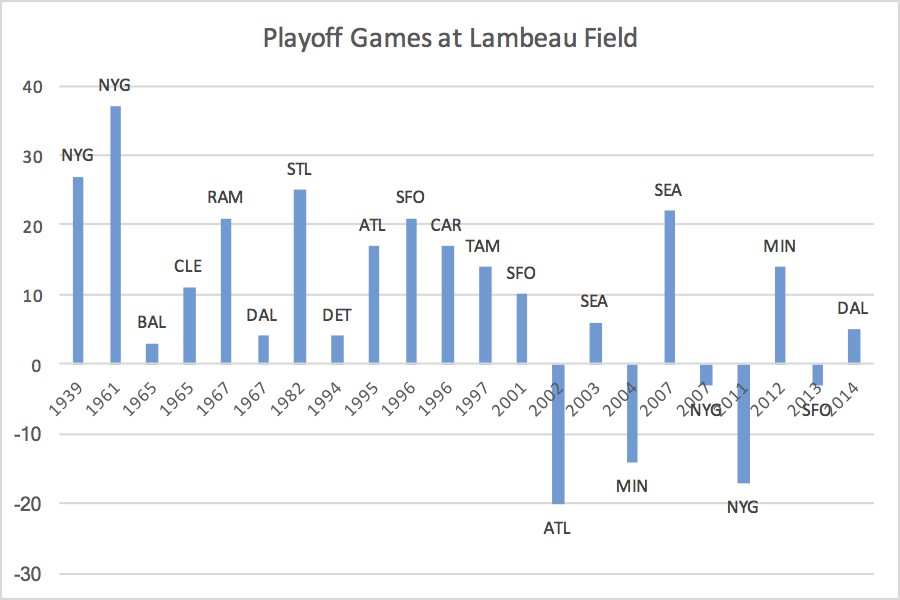On Friday, the AP announced the 2016 All-Pro teams. One confusing change this year: the removal of the fullback and the second running back spot (there used to be 12 first-team All-Pros on offense), and the substitution of a “Flex” spot that seems to go to… anyone? David Johnson finished second in running back voting, but first in Flex voting, whatever that means. And while 12 1APs may not make sense, there are still 12 on defense, which makes it pretty odd. There’s also now a defensive back category in addition to CB and S, which… again, I don’t quite get. But there are 2 first team edge rushers, 2 interior defenders, 3 linebackers, 2 cornerbacks, 2 safeties, and one defensive back.
Quarterback
Matt Ryan, Atlanta, 29; Tom Brady, New England, 15; Aaron Rodgers, Green Bay, 5; Derek Carr, Oakland, 1.
Running Backs
Ezekiel Elliott, Dallas, 47; David Johnson, Arizona, 3.
Wide Receivers
Antonio Brown, Pittsburgh, 43; Julio Jones, Atlanta, 30; Odell Beckham Jr., New York Giants, 16; Mike Evans, Tampa Bay, 6; Jordy Nelson, Green Bay 5.
Tight End
Travis Kelce, Kansas City, 44; Greg Olsen, Carolina, 5; Rob Gronkowski, New England, 1.
Flex
David Johnson, Arizona, 24; Le’Veon Bell, Pittsburgh, 18; Odell Beckham, New York Giants, 3; Antonio Brown, Pittsburgh, 1; Larry Fitzgerald, Arizona, 1; LeSean McCoy, Buffalo, 1; Jarvis Landry, Miami, 1; Travis Kelce, Kansas City, 1.
Left Tackle
Tyron Smith, Dallas, 27; David Bakhtiari, Green Bay, 8; Joe Thomas, Cleveland, 7; Trent Williams, Washington, 3; Jason Peters, Philadelphia, 2; Taylor Lewan, Tennessee, 1; Donald Penn, Oakland, 1; Andrew Whitworth, Cincinnati, 1.
Right Tackle
Jack Conklin, Tennessee, 27 1-2; Mitchell Schwartz, Kansas City, 6; Marcus Cannon, New England, 6; Bryan Bulaga, Green Bay, 5 1-2; Zach Strief, New Orleans, 2; Ryan Schraeder, Atlanta, 2; Marcus Gilbert, Pittsburgh, 1;
Left Guards
Kelechi Osemele, Oakland, 47; Marshal Yanda, Baltimore, 2; James Carpenter, New York Jets, 1. Right Guard
Zack Martin, Dallas, 40; David DeCastro, Pittsburgh, 5; Marshal Yanda, Baltimore, 4; Kevin Zeitler, Cincinnati, 1.
Center
Travis Frederick, Dallas, 29; Alex Mack, Atlanta, 14; Rodney Hudson, Oakland, 5; Maurkice Pouncey, Pittsburgh, 1, Brandon Linder, Jacksonville, 1.
Defensive Players
Edge Rushers
Khalil Mack, Oakland, 46; Vic Beasley Jr., Atlanta, 30; Cameron Wake, Miami, 3; Olivier Vernon, Miami, 3; Jadeveon Clowney, Houston,m 3; Brandon Graham, Philadelphia, 3; Michael Bennett, Seattle, 2; Cameron Jordan, New Orleans, 2; Danielle Hunter, Minnesota, 2; Cliff Avril, Seattle, 2; Everon Griffen, Minnesota, 1; Joey Bosa, San Diego, 1.
Interior Linemen
Aaron Donald, St. Louis, 47; Damon Harrison, New York Giants 16; Ndamukong Suh, Miami, 12; Calais Campbell, Arizona, 7; Gerald McCoy, Tampa Bay, 7; Fletcher Cox, Philadelphia, 6; Geno Atkins, Cincinnati, 5.
Linebackers
Bobby Wagner, Seattle, 48; Von Miller, Denver, 47; Sean Lee, Dallas, 41; Lorenzo Alexander, Buffalo, 4; Luke Kuechly, Carolina, 2; C.J. Mosley, Baltimore, 1; Zach Brown, Buffalo, 1; Zachary Orr, Baltimore, 1; Alec Ogletree, Los Angeles, 1; Dont’a Hightower, New England, 1; Bernardick McKinney, Houston, 1; Lavonte David, Tampa Bay, 1; Whitney Mercilus, Houston, 1.
Cornerbacks
Aqib Talib, Denver, 27; Marcus Peters, Kansas City, 23; Janoris Jenkins, New York Giants, 17; Malcolm Butler, New England, 8; Casey Hayward, San Diego, 8; Richard Sherman, Seattle, 7; Xavier Rhodes, Minnesota, 5; Chris Harris, Jr., Denver, 4; Dominique Rodgers-Cromartie, New York Giants, 1.
Safeties
Landon Collins, New York Giants, 47; Eric Berry, Kansas City, 31; Devin McCourty, New England, 4; Ha Ha Clinton-Dix, Green Bay, 4; Earl Thomas, Seattle, 3; Harrison Smith, Minnesota, 3; Reggie Nelson, Cincinnati, 2; Kam Chancellor, Seattle, 2; Malcolm Jenkins, Philadelphia, 1; Eric Weddle, Baltimore, 1; Quintin Demps, Houston, 1; Darian Stewart, Denver, 1.
Defensive Back
Chris Harris, Jr., Denver, 14; Dominique Rodgers-Cromartie New York Giants, 6; Malcolm Butler, New England, 5; Eric Berry, Kansas City 3; Casey Hayward, San Diego, 3; Malcolm Jenkins, Philadelphia, 3; Patrick Peterson, Arizona, 2; Marcus Peters, Kansas City, 2; Xavier Rhodes, Minnesota, 2; Ha Ha Clinton-Dix, Green Bay, 2; Janoris Jenkins, New York Giants, 2; Aqib Talib, Denver, 1; Darius Slay, Detroit, 1; Devin McCourty,, New England, 1; Brent Grimes, Tampa Bay, 1; Richard Sherman, Seattle, 1; Eric Weddle, San Diego, 1.
Special Teams
Placekicker
Justin Tucker, Baltimore, 50.
Punter
Johnny Hekker, Los Angeles, 42; Marquette King, Oakland, 4; Pat McAfee, Indianapolis, 2; Brad Wing, New York Giants, 1; Sam Martin, Detroit, 1.
Kick Returner
Cordarrelle Patterson, Minnesota, 41; Tyler Lockett, Seattle, 5; Tyreek Hill, Kansas City, 5.
Punt Returner
Tyreek Hill, Kansas City, 50.
Special Teamer
Matt Slater, New England, 14; Nate Ebner, New England, 12; Dwayne Harris, New York Giants, 6; Justin Bethel, Arizona, 3; James Develin, New England, 3; Michael Thomas, Miami, 3; Chase Reynolds, Los Angeles, 3; Eric Murray, Kansas City, 2; Chris Maragos, Philadelphia, 1; Eric Weems, Atlanta, 1; Josh Bellamy, Chicago, 1.





